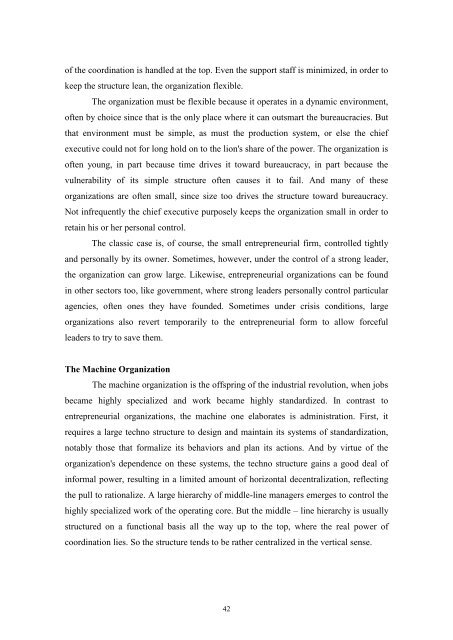DSpace at Khazar University
DSpace at Khazar University
DSpace at Khazar University
Create successful ePaper yourself
Turn your PDF publications into a flip-book with our unique Google optimized e-Paper software.
of the coordin<strong>at</strong>ion is handled <strong>at</strong> the top. Even the support staff is minimized, in order to<br />
keep the structure lean, the organiz<strong>at</strong>ion flexible.<br />
The organiz<strong>at</strong>ion must be flexible because it oper<strong>at</strong>es in a dynamic environment,<br />
often by choice since th<strong>at</strong> is the only place where it can outsmart the bureaucracies. But<br />
th<strong>at</strong> environment must be simple, as must the production system, or else the chief<br />
executive could not for long hold on to the lion's share of the power. The organiz<strong>at</strong>ion is<br />
often young, in part because time drives it toward bureaucracy, in part because the<br />
vulnerability of its simple structure often causes it to fail. And many of these<br />
organiz<strong>at</strong>ions are often small, since size too drives the structure toward bureaucracy.<br />
Not infrequently the chief executive purposely keeps the organiz<strong>at</strong>ion small in order to<br />
retain his or her personal control.<br />
The classic case is, of course, the small entrepreneurial firm, controlled tightly<br />
and personally by its owner. Sometimes, however, under the control of a strong leader,<br />
the organiz<strong>at</strong>ion can grow large. Likewise, entrepreneurial organiz<strong>at</strong>ions can be found<br />
in other sectors too, like government, where strong leaders personally control particular<br />
agencies, often ones they have founded. Sometimes under crisis conditions, large<br />
organiz<strong>at</strong>ions also revert temporarily to the entrepreneurial form to allow forceful<br />
leaders to try to save them.<br />
The Machine Organiz<strong>at</strong>ion<br />
The machine organiz<strong>at</strong>ion is the offspring of the industrial revolution, when jobs<br />
became highly specialized and work became highly standardized. In contrast to<br />
entrepreneurial organiz<strong>at</strong>ions, the machine one elabor<strong>at</strong>es is administr<strong>at</strong>ion. First, it<br />
requires a large techno structure to design and maintain its systems of standardiz<strong>at</strong>ion,<br />
notably those th<strong>at</strong> formalize its behaviors and plan its actions. And by virtue of the<br />
organiz<strong>at</strong>ion's dependence on these systems, the techno structure gains a good deal of<br />
informal power, resulting in a limited amount of horizontal decentraliz<strong>at</strong>ion, reflecting<br />
the pull to r<strong>at</strong>ionalize. A large hierarchy of middle-line managers emerges to control the<br />
highly specialized work of the oper<strong>at</strong>ing core. But the middle – line hierarchy is usually<br />
structured on a functional basis all the way up to the top, where the real power of<br />
coordin<strong>at</strong>ion lies. So the structure tends to be r<strong>at</strong>her centralized in the vertical sense.<br />
42

















